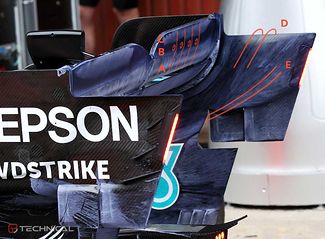Mercedes W10 rear wing airflow explained with flow-viz
Testing usually sees teams apply flowviz paint on their cars to visualize airflow on certain car elements. They do so to verify the findings from the windtunnel and detect any unwanted effect that was not simulated.
So did Mercedes, revealing airflow on the suction surface of the rear wing and its endplates (flows D and E).
It is clear in the image that airflow has drawn straight lines onto the suction surface of the main flap. This shows perfect laminar flow, as one would expect with this element.
Things get interesting when we look at flow behind the upper flap. As additional high speed flow is injected through the slot, the laminar flow is even more obviously 'painted' onto the wing (A).
However, it doesn't remain as such, as about halfway up the flap, flow separates from the wing (obvious by the unpainted section B). It later rejoins the wing in a turbulent fashion (C).
This is called a laminar separation bubble, an aerodynamic effect that can happen due to a strong adverse pressure gradient - and related velocity drop - along the surface, which makes the laminar boundary layer separate from the wing surface.
As the flow is separated, it transitions to a turbulent flow, increasing the momentum transfer into the boundary layer and leading to a reattachment.
Now, what does this mean for the Mercedes W10? The flow pattern that we see is perfectly acceptable. It shows that the wing is working airflow extremely hard. In fact, the separation bubble can under certain conditions increase downforce due to the increase in effective camber of the wing, but one thing it will do is add come drag.
Making the wing even more aggressive could mean the flow wouldn't rejoin the wing, resulting in a loss of downforce. There are of course solutions to this, such as turbulators, but no doubt, Mercedes's vast team or aerodynamicists have already considered this option as well.
Time will tell if the team opts to modify its rear wing design to alter flow characterics.

